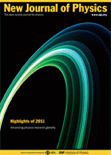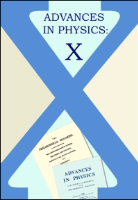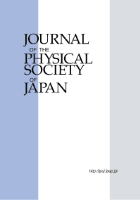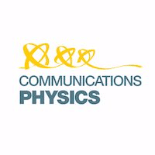
ACTA PHYSICA SINICA
Scope & Guideline
Connecting Innovators in Physics and Astronomy
Introduction
Aims and Scopes
- Condensed Matter Physics:
Research focusing on the properties and behaviors of solid and liquid matter, including studies on phase transitions, electronic properties, and magnetism. - Quantum Mechanics and Quantum Information:
Exploration of quantum states, entanglement phenomena, and their applications in quantum computing and information technologies. - Photonics and Optoelectronics:
Studies involving light generation, manipulation, and detection, including advancements in lasers, photonic devices, and quantum optics. - Materials Science and Engineering:
Research on the synthesis, characterization, and application of novel materials, including semiconductors, nanomaterials, and superconductors. - Plasma Physics:
Investigations into plasma behavior, interactions, and applications in fields such as fusion energy, astrophysics, and space science. - Acoustics and Ultrasonics:
Research related to sound wave propagation, acoustic materials, and applications in imaging and sensing technologies. - Theoretical Physics:
Development of theoretical models and frameworks to understand complex physical systems and phenomena.
Trending and Emerging
- Quantum Computing and Quantum Information Science:
A rapid increase in publications focusing on quantum algorithms, quantum cryptography, and quantum simulations, reflecting the growing importance of quantum technologies. - Nanotechnology and Two-Dimensional Materials:
Research on graphene, transition metal dichalcogenides, and other two-dimensional materials is gaining momentum, emphasizing their unique properties and applications in electronics and photonics. - Machine Learning Applications in Physics:
The integration of machine learning techniques in experimental and theoretical physics is emerging as a vital area, enhancing data analysis and model predictions. - Terahertz Technology:
An uptick in studies related to terahertz wave applications, particularly in sensing and imaging, indicating a growing interest in this frequency range. - Plasmonics and Metamaterials:
Research into plasmonic materials and metamaterials is on the rise, focusing on their potential applications in enhanced light-matter interactions and novel optical devices. - Energy Materials and Sustainability:
A significant increase in research aimed at developing sustainable energy materials, including perovskite solar cells and thermoelectric materials, reflecting global energy challenges.
Declining or Waning
- Classical Electrodynamics:
Research in classical electrodynamics has become less prominent, possibly due to the increasing focus on quantum and relativistic effects in modern physics. - Traditional Semiconductor Physics:
Studies centered solely on conventional semiconductor physics are waning, as the field shifts towards more complex materials and novel heterostructures. - Static Analysis Techniques:
Static modeling approaches are being overshadowed by dynamic and computational techniques that offer greater insights into transient phenomena. - Thermal and Fluid Dynamics in Traditional Settings:
Research focused on conventional thermal and fluid dynamics is seeing reduced attention compared to more innovative applications in nanofluids and complex systems. - Basic Optical Measurement Techniques:
Standard optical measurement methods are being replaced by more sophisticated approaches that incorporate machine learning and advanced imaging techniques.
Similar Journals

JOURNAL OF THE KOREAN PHYSICAL SOCIETY
Empowering Researchers with Cutting-Edge FindingsJOURNAL OF THE KOREAN PHYSICAL SOCIETY is a prominent academic journal dedicated to advancing the field of physics, published by the prestigious Korean Physical Society. With its extensive contribution to the scientific community since its inception in 1996, this journal serves as an essential platform for the dissemination of innovative research findings in various branches of physical science. Despite its current categorization in Q4 and a ranking reflecting its early-stage impact relative to peers, it remains a valuable resource for researchers, professionals, and students eager to explore developments in general physics and astronomy. The journal is accessible in both print and electronic formats, making it convenient for a global audience. Each issue aims to foster collaboration and knowledge-sharing within the field, ensuring that it remains relevant and instrumental in shaping future research directions. Located in South Korea, the journal continues to nurture a vibrant academic community, contributing to the ongoing dialogue in the global scientific arena.

NEW JOURNAL OF PHYSICS
Bridging theory and practice in contemporary physics.NEW JOURNAL OF PHYSICS, published by IOP Publishing Ltd, is a prestigious open-access journal that has been at the forefront of the physics community since its inception in 1998. With an impact factor that places it in the Q1 category of Physics and Astronomy (miscellaneous) and a commendable ranking of #49 out of 243 in the general physics and astronomy category according to Scopus, this journal is recognized for its significant contribution to advancing research in the field. The journal caters to a broad scope of topics, providing a platform for the dissemination of cutting-edge research findings and innovative theoretical explorations. Operating from the United Kingdom, it offers a truly international perspective, making its contents accessible and impactful to a global audience. With robust open-access options, the NEW JOURNAL OF PHYSICS ensures that research findings are freely available, promoting collaboration and knowledge sharing among researchers, professionals, and students alike. This commitment to accessibility, combined with its high-quality content, makes it an essential resource for anyone engaged in the physics community.

Advances in Physics-X
Exploring the Boundaries of Physics and AstronomyAdvances in Physics-X is a premier open-access journal published by Taylor & Francis Ltd, dedicated to advancing the frontiers of knowledge in the field of Physics and Astronomy. Since its inception in 2016, the journal has established itself as a vital platform for researchers and professionals, showcasing innovative research and cutting-edge theories that influence a broad array of sub-disciplines within physics. With an impressive impact factor and ranked in the 94th percentile among its peers, it resides in the Q1 category for Physics and Astronomy (miscellaneous), indicating its significant contributions to the academic community. Located in the United Kingdom, the journal encourages open access to foster wider dissemination and visibility of scholarly works, aligning with contemporary academic trends that prioritize global knowledge sharing. The ongoing commitment to publishing high-quality research ensures that Advances in Physics-X remains an essential resource for students, industry experts, and academics alike, helping to shape the future of physics research through collaboration and innovation.

INDIAN JOURNAL OF PHYSICS
Advancing the Frontiers of Physics and AstronomyINDIAN JOURNAL OF PHYSICS, published by the Indian Association for Cultivation of Science, serves as a pivotal platform for researchers and scholars in the field of physics and astronomy. With its ISSN 0973-1458 and E-ISSN 0974-9845, this journal is committed to presenting innovative research and developments across diverse topics in physics, covering both theoretical and experimental studies. The journal has made its mark in the academic community, evidenced by its classification in the Q3 category within the Physics and Astronomy domain as of 2023, and ranks #100 out of 243 in the Scopus curated database, placing it in the 59th percentile. Spanning from 2005 to 2024, the INDIAN JOURNAL OF PHYSICS aims to foster knowledge exchange and stimulate discussions among physicists and scientific enthusiasts. Whether you are a researcher looking to publish your findings, a professional seeking updates in your field, or a student eager to explore varying aspects of physics, this journal is an invaluable resource contributing significantly to the understanding and advancement of physics in India and beyond.

BRAZILIAN JOURNAL OF PHYSICS
Advancing Knowledge in Physics and AstronomyBRAZILIAN JOURNAL OF PHYSICS, published by SPRINGER, is a prominent platform dedicated to the dissemination of research within the realm of physics and astronomy. With an ISSN of 0103-9733 and E-ISSN of 1678-4448, this esteemed journal has been contributing to the field since its inception in 1996, and it continues to be pivotal in showcasing innovative studies and breakthroughs. The journal is categorized in the Q4 quartile for the year 2023, reflecting a dedicated focus on advancing knowledge across a variety of disciplines, particularly in general physics and astronomy, where it ranks 126th out of 243 in Scopus rankings. Although it currently does not operate under an open-access model, it remains an invaluable resource for researchers, professionals, and students eager to enhance their understanding of complex physical principles and developments. The journal is committed to promoting high-quality research, bridging gaps in knowledge, and fostering collaboration within the global physics community.

JOURNAL OF THE PHYSICAL SOCIETY OF JAPAN
Advancing the Frontiers of Physics and AstronomyThe JOURNAL OF THE PHYSICAL SOCIETY OF JAPAN, published by the Physical Society of Japan, has been at the forefront of advancing knowledge in the field of Physics and Astronomy since its inception in 1946. With a commendable reputation reflected in its Q2 ranking within its category for 2023, this journal serves as a vital platform for disseminating high-quality research and innovative concepts. Researchers and professionals alike can engage with cutting-edge studies and reviews that span a diverse range of topics pivotal to the physical sciences. Although the journal does not currently operate with an open access model, it maintains a robust impact on the global physics community, evidenced by its placement in the 59th percentile among a competitive pool of 243 journals. With an unwavering commitment to bridging theory and application, the JOURNAL OF THE PHYSICAL SOCIETY OF JAPAN continues to inspire and cultivate scholarly discourse and collaboration across disciplines.

Jurnal Fizik Malaysia
Advancing Physics Knowledge, One Article at a Time.Jurnal Fizik Malaysia is a prominent academic journal dedicated to advancing the field of physics, published by the esteemed Institut Fizik Malaysia. With an aim to foster knowledge dissemination and research collaboration among physicists, the journal serves as a vital platform for original research articles, reviews, and technical notes that cover various sub-disciplines of physics. Although the journal operates under a traditional subscription model, its commitment to quality has been bolstered by a rigorous peer-review process, ensuring high academic standards. Researchers and students in Malaysia and beyond are encouraged to engage with this journal, contributing to a deeper understanding of physical sciences and its applications. Moreover, with its ISSN 0128-0333, Jurnal Fizik Malaysia continues to play a significant role in the scientific community, enhancing visibility and accessibility for local and international research outputs in the ever-evolving landscape of physics.

Communications Physics
Catalyzing discoveries in the realm of Physics and Astronomy.Communications Physics is a premier open access journal published by Nature Portfolio, dedicated to disseminating high-quality research in the field of Physics and Astronomy. Since its inception in 2018, the journal has rapidly established itself as a vital platform for innovative scientific communication, boasting an impressive Impact Factor and achieving Q1 status in the 2023 category of Physics and Astronomy (miscellaneous). With a Scopus rank of #31 out of 243, placing it within the 87th percentile, Communications Physics attracts a global audience of researchers, professionals, and students eager to engage with cutting-edge findings. The journal supports open access, ensuring that research is freely available to the public, which enhances its visibility and encourages broader discussions within the scientific community. Located in Berlin, Germany, Communications Physics aims to bridge the gap between various disciplines within physics, fostering interdisciplinary collaboration and inspiring future research endeavors.

ACTA PHYSICA POLONICA A
Fostering Knowledge Exchange in the Physics CommunityACTA PHYSICA POLONICA A is a distinguished peer-reviewed journal published by the Polish Academy of Sciences Institute of Physics, offering a platform for disseminating cutting-edge research in the field of physics and astronomy. With an ISSN of 0587-4246 and an E-ISSN of 1898-794X, this journal has been a staple for scholars since its inception, converging its publication years from 1996 to 2024. Despite its current Q4 classification in the Physics and Astronomy (miscellaneous) category, ACTA PHYSICA POLONICA A provides valuable insights and breakthroughs addressing various aspects of general physics. Researchers, professionals, and students will find a wealth of knowledge within its pages, even as it operates in an evolving academic landscape. While subscription options exist, the journal aims to foster collaboration and knowledge exchange in the physics community, making it a vital resource for those seeking to stay at the forefront of research advancements.

Physical Review Research
Bridging ideas and innovation in physics and astronomy.Physical Review Research, published by the American Physical Society, is a premier open access journal dedicated to the dissemination of high-quality research across all areas of physics and astronomy. Since its inception in 2019, this journal has quickly established itself as a vital platform for researchers, achieving a prestigious Q1 ranking in the dynamics of Physics and Astronomy (miscellaneous) and holding a commendable position in the Scopus Rankings with a rank of #29 out of 243, placing it in the 88th percentile. With the commitment to fostering scientific collaboration and transparency, Physical Review Research offers unrestricted access to valuable findings, enabling researchers, professionals, and students alike to engage with cutting-edge contributions in general physics and astronomy. As it converges into its forthcoming years of publication, the journal remains dedicated to showcasing rigorous research and innovative ideas that drive the field forward.